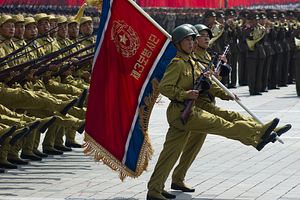Kim Jong-un has begun the year warning of an imminent nuclear war.
North Korea’s bellicose threats have been historically consistent and relatively hollow, yet their developing content and context aid South Korean and U.S. analysts in understanding how best to judge and engage with the Hermit Kingdom. Pyongyang has repeatedly predicted nuclear demise, but with an inexperienced leader amidst changing domestic and international conditions, the threat must still be taken seriously
Here, we consider the most significant threats made by North Korea in 2013.
No. 5 – December 16, 2013: One Suggestion: Run.
“Baengnyeong Island will become a huge grave. If you don’t want to be a ghost in a hell fire, you better decide. We can give you only one suggestion. Run.”
As the validity of Jang Song-thaek’s execution began to be feverishly investigated, North Korea released this threat via propaganda pamphlets on the beaches of South Korea’s Baengnyeong Island. This threat was clearly made to deter attention away from North Korea’s leadership troubles. Baengnyeong likely chosen for its previous significance following the Cheonan incident of 2010. The threat contained consistent features of previous threats except that it was the first made following a significant leadership purge.
No. 4 – December 20, 2013: Kim Jong-il Unfavorably Remembered
“…merciless retaliatory acts without warning…”
“…[South Korea has] insulted our highest dignity…”
The anniversary of Kim Jong-il’s death caused crowds of South Koreans to protest in Seoul and publically burn effigies of the Kim dynasty. Ironically, this threat of advanced technical attacks was sent via fax. Considering the caliber and context of threats delivered throughout 2013, this threat was limited compared to its predecessors, however, important conditions had changed as the year ended. The first was the execution of Kim Jong-il’s senior advisor and his intentions for reform. The second was the end of his influence on China and South Korea. This threat was likely a tactic to reinstate Pyongyang’s power and (alleged) unity to the world.
No. 3 – November 22, 2013: The Sea of Fire
“If the South recklessly provokes us again, the sea of fire at Yeonpyeong will turn into a sea of fire at the Blue House,”
These remarks were made on the anniversary of the shelling of Yeonpyeong Island in 2010 that killed two South Korean marines and two civilians. The casualties and damage of South Korea’s retaliatory shelling into North Korea have never been disclosed, however, Kim Jong-un’s public contempt and antagonism surrounding this time of year has been consistent. At the same time in 2012, Kim Jong-un mentioned that his only regret was not bombing Yeonpyeong to “the bottom of the sea.” Although comments in 2012 referenced another attack on Yeonpyeong, the 2013 Yeonpyeong threats were escalated by directly referencing the Blue House as an imminent target.
No. 2 – April 3, 2013: The Moment of Explosion Is Approaching
“The moment of explosion is approaching fast. No one can say a war will break out in Korea or not and whether it will break out today or tomorrow,”
This threat followed the UN Security Council Resolution 2094 (see below). It coincided with North Korea blocking South Korean workers crossing the border to the Kaesong Industrial Complex (KIC), a joint economic venture between both nations, and the announcement to restart a previously closed nuclear plant. Closing the KIC was an unpredicted and illogical move that severed a crucial flow of hard currency for the North. With this threat, the U.S. decided to bring forward the deployment of an advanced missile defense system in Guam by two years. It also deployed two Aegis-equipped missile equipped warships into the Pacific to monitor North Korea. Although the U.S. presence seems to incite North Korean aggression, in this case it is apparent that increased measures can also act as a deterrent.
No. 1 – March 5, 2013: The Korean Armistice Agreement in Jeopardy
“The KPA Supreme Command will make the Korean Armistice Agreement totally nullified.”
This descriptive North Korean piece was delivered during discussions of UN Security Council Resolution 2094 (2013), endorsing economic sanctions against the Hermit Kingdom for the latter’s breach of previous resolutions regarding nuclear tests. The threat, as mentioned within the lengthy and unusual statement, also corresponded with the occurring Key Resolve and Fowl Eagle joint military exercises between South Korea and the U.S. Pyongyang did not act on the threat, and a White House spokesperson admitted that this “rhetoric” followed an uneventful pattern. On this occasion, China was instrumental during the negotiation process and demonstrated the dynamic North Korean-Chinese relationship. The full threat can be viewed here.
What to conclude from these utterances? The most consistent pattern is how the presence of the U.S., specifically its military, has caused North Korea to produce threats in what is likely a natural defense mechanism. However, the U.S. is likely deterring North Korea from irrational progressions.
The importance North Korea places on commemorative events is another insight, with Yeonpyeong, Cheonan and Kim Jong-il’s death all providing annual threat occurrences. The threat of nullifying the Korean Armistice Agreement has elevated this trend.
North Korea may be reluctant to engage in immediate military action, but the erratic attacks on 2010 and the 2013 KIC shutdown demonstrate its ability to inflict damage on its international relations or economy to stubbornly prove a point.
Jang Song-thaek’s execution has had profound effects for North Korea’s leadership and its international alliances. Kim Jong-un is young, proud, and no longer advised by the senior mentor from his father’s reign. China, having supported Resolution 2094, is likely to reassess its relationship to North Korea now that the latter’s entrusted representative has been purged.
It is a New Year and with it comes new challenges. Perhaps cooperation and peace can be better achieved in consideration of last year’s threats.
Dominic Meoli is a postgraduate student completing a Master of International Law and International Relations at the University of New South Wales, Australia.

































